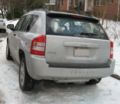2007 Jeep Compass Owner's Manual - Page 270
2007 Jeep Compass Manual
Page 270 highlights
270 STARTING AND OPERATING placard pressure in order for the TPM warning lamp to be turned off. The system will automatically update and the TPM warning lamp will extinguish once the updated tire pressures have been received. The vehicle may need to be driven for up to 10 minutes above 15 mph (25 km/h) to receive this information. For example, your vehicle may have a recommended cold (parked for more than 3 hours) placard of 35 °F (241 kPa). If the ambient temperature is 68 °F (20 °C) and the measured tire pressure is 30 psi (207 kPa), a temperature drop to 20 °F (-7 °C) will decrease the tire pressure to approximately 26 psi (179 kPa). This tire pressure is sufficiently low enough to turn ON the "Tire Pressure Monitoring Light". Driving the vehicle may cause the tire pressure to rise to approximately 30 psi (207 kPa), but the "Tire Pressure Monitoring Light" will still be ON. In this situation, the "Tire Pressure Monitoring Light" will turn OFF only after the tires have been inflated to the vehicle's recommended cold placard pressure value. Premium System - If Equipped The Tire Pressure Monitor System (TPMS) uses wireless technology with wheel rim mounted electronic sensors to monitor tire pressure levels. Sensors, mounted to each wheel as part of the valve stem, transmit tire pressure readings to the Receiver Module. NOTE: It is particularly important, for you to check the tire pressure in all of your tires regularly and to maintain the proper pressure. The TPMS consists of the following components: • Receiver Module • 4 Tire Pressure Monitoring Sensors • 3 Trigger Modules (mounted in three of the four wheel wells)
















